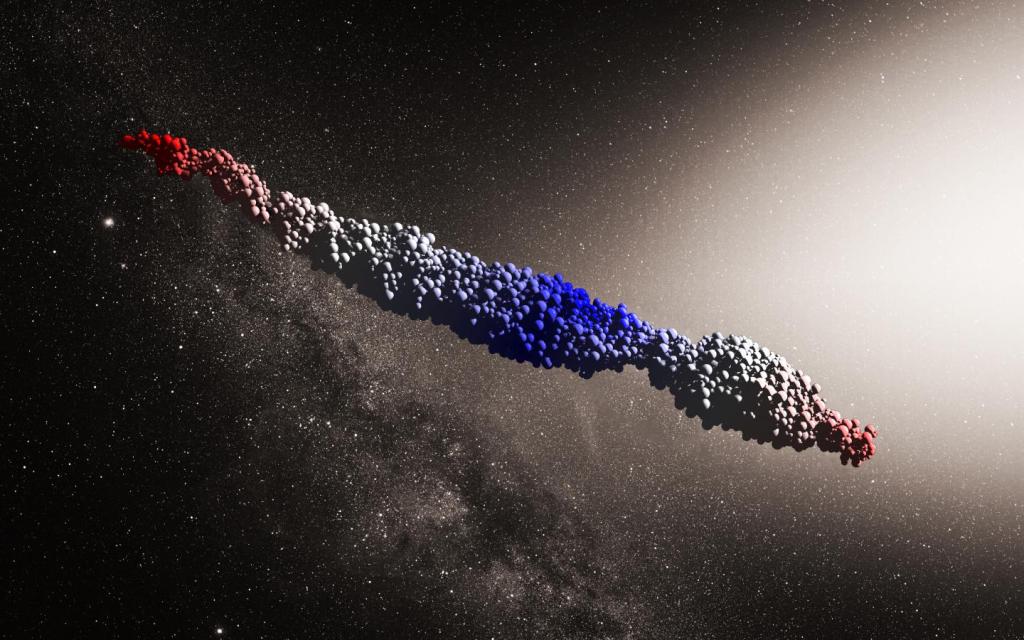Two years ago, scientists found the first visitor from interstellar space ever spotted inside the solar system. The trajectory of the elongated object, named ʻOumuamua, showed that it originated in an unknown star system that must have ejected it a long time ago.
Since then, debates have raged about the formation of this blunt-shaped traveler, including speculation that it is a UFO (note: it’s not aliens).
Videos by VICE
Now, scientists propose that ʻOumuamua was part of a larger celestial body that was whittled into oblong splinters during tight passes with its host star. The star’s tidal forces then booted it into the interstellar wilds, an origin story that may be common for interstellar objects (ISOs) in our galaxy, according to a study published on Monday in Nature Astronomy.
“Our research provides a possible explanation for ‘Oumuamua’s origin, and we also showed that the prolificacy of this kind of interstellar object and suggested that the formation process is ubiquitous in the Milky Way Galaxy,” said lead author Yun Zhang, a planetary scientist at the Observatoire de la Côte d’Azur in France, in an email.
“We expect to see more interstellar objects coming to our solar system in the future, and then we can compare their properties and population with ‘Oumuamua to make a more accurate estimation about their occurrence rate,” she added.

Scientists have been ruminating about ʻOumuamua’s backstory ever since the object was first spotted in October 2017 by the Pan-STARRS telescope in Hawaii. At that point, the object had already made its closest pass to the Sun and was hurtling back out of the solar system.
Weirdly, ʻOumuamua is about 10 times longer than it is wide, creating bizarre proportions that don’t match any known objects inside our own solar system. Scientists also searched for ice and gas trailing the object, a sign it might be a comet, but saw nothing. Instead, ʻOumuamua appears to have a dark reddish color indicating that it is rich in metals and organic compounds. While it may have once been a comet, the object is now considered an asteroid.
In order to square all of these unusual features, Zhang and co-author Douglas Lin, an astronomer at UC Santa Cruz, ran high-resolution computer simulations of various celestial bodies—such as comets, debris, or even planets—approaching stars. The results predicted that a star about half the size of the Sun could shred large objects into these fragments, some of which would have even more elongated axis ratios than ʻOumuamua (perhaps more of a joint shape than a blunt shape).
Close stellar encounters would also cause the surface of the shards to melt, then solidify once the objects receded from the intense heat and radiation of the star. This process could essentially coat the objects in natural glue, causing an “enhancement of cohesion” that offers “a possible formation scenario for the reported shape, size, and surface features of ‘Oumuamua,” according to the study.

A single star system may eject trillions of these objects over the course of several billion years, the team estimated, so interstellar space is no doubt filled with shattered travelers. Indeed, last year, scientists discovered another visitor from interstellar space called comet 2I/Borisov, and they expect to spot many more in the coming decades.
“The interstellar objects’ ejection are stirred by mutual effects during different stages of planetary system evolution,” Zhang said. “Some specific planetary formation and evolution processes can also be tested by analyzing these interstellar objects.”
“Spectral interpretation from observations in the future also could help to reveal some of their chemical properties and make some links to solar system small bodies,” she continued. “It would be cool if we could have some space missions go to upcoming interstellar objects to analyze if they contain any chemical precursors of life.”
Ejected asteroids, comets, and even planets are drifting across the galaxy, occasionally getting captured by the gravity of random star systems. They may carry and distribute the ingredients for life, such as water and organic compounds, “between stars near and far,” Zhang and Lin said in the study.
“It’s possible that simple organic compounds and complex organic molecules can be preserved in these asteroidal ISOs,” Zhang explained. “There is some evidence that organic molecules are abundant in some asteroids, comets, or meteorites. These organic compounds are believed to be the potential ingredients for life to start.”
“If some systems’ planetary bodies contain such ingredients, they may distribute around the galaxy by the interstellar objects,” she said.
Update: This article has been updated with comments from lead author Yun Zhang.




